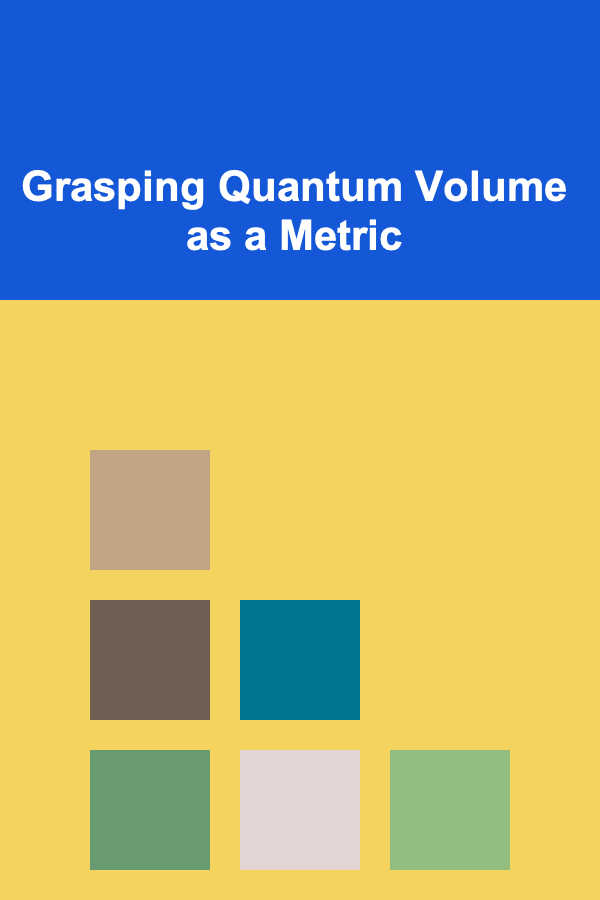
Grasping Quantum Volume as a Metric
ebook include PDF & Audio bundle (Micro Guide)
$12.99$10.99
Limited Time Offer! Order within the next:

Quantum computing, once a theoretical dream, is rapidly transitioning into a tangible reality. As quantum processors become increasingly sophisticated, the need for reliable and standardized metrics to evaluate their performance becomes paramount. Among the various metrics proposed, Quantum Volume (QV) has emerged as a key indicator, aiming to capture the overall capabilities of a quantum computer. This article delves deep into the concept of Quantum Volume, exploring its motivation, methodology, limitations, and future directions. We will unpack the mathematics and the underlying philosophy behind it, providing a comprehensive understanding of this vital benchmark.
The Need for a Holistic Metric
Before Quantum Volume, benchmarking quantum computers primarily focused on individual aspects like qubit count, coherence time, and gate fidelity. While important, these metrics paint an incomplete picture. A large number of qubits doesn't guarantee superior performance if those qubits are riddled with errors or lack connectivity. Similarly, long coherence times are meaningless if gate operations are unreliable. What was lacking was a single metric that could capture the interplay between these different parameters and provide a holistic assessment of a quantum computer's power.
Consider the analogy of comparing different types of classical computers. Knowing the clock speed of a processor or the amount of RAM is insufficient to determine which machine is truly faster for a specific task. Factors like the architecture of the processor, the speed of the hard drive, and the efficiency of the operating system all contribute to the overall performance. Similarly, Quantum Volume aims to provide a more complete picture of a quantum computer's capabilities, taking into account qubit connectivity, gate fidelity, and coherence time. It attempts to abstract away from the individual hardware specifications and provide a task-based metric that reflects the size of the "quantum circuit" the machine can successfully execute.
Defining Quantum Volume
Quantum Volume (QV) is defined as the size of the largest square quantum circuit that a quantum computer can successfully implement with high fidelity. More formally, it is often expressed as:
QV = 2^n^
where n is the number of qubits in the largest successfully executed square circuit. A "square circuit" in this context refers to a quantum circuit with an equal number of qubits (n) and layers (also n). The key here is that the circuit must be "successfully executed." This means that the results obtained from the quantum computer must closely match the expected results from a perfect simulation. This requirement forces the quantum computer to overcome errors and noise inherent in its hardware.
The exponentiation by 2 highlights the exponential scaling of quantum computation. A Quantum Volume of 64 (2^6^) represents a machine that can successfully execute circuits with 6 qubits and 6 layers. This might seem small, but the complexity of these circuits grows exponentially with the number of qubits, representing a significant computational challenge for classical computers to simulate. The greater the QV, the more complex quantum algorithms the machine can potentially execute.
The Quantum Volume Circuit
The specific type of circuit used to measure Quantum Volume is carefully chosen to stress all aspects of the quantum computer's architecture. It is designed to be a pseudo-random circuit composed of two fundamental operations:
- Random Permutation: A randomly generated permutation, represented by a unitary matrix, is applied to the qubits. This permutation shuffles the quantum state across the qubits, effectively testing their connectivity. Good connectivity is crucial because it allows quantum information to be spread evenly throughout the device, maximizing the potential for entanglement and complex quantum computations.
- Two-Qubit Gate: After the permutation, a layer of random two-qubit gates is applied. These gates are typically CNOT (Controlled-NOT) gates, but other two-qubit gates can also be used. These gates are crucial for creating entanglement between qubits, a fundamental requirement for quantum computation. The placement of these gates is also randomized to ensure that all pairs of qubits are tested.
These two operations are repeated for each layer of the circuit. The randomness in the permutation and gate placement is essential for ensuring that the Quantum Volume test does not favor a specific architecture or gate set. It aims to provide a general-purpose benchmark that is applicable to different types of quantum computers.
Mathematically, each layer of the QV circuit can be represented as follows:
U~i~= P~i~* C~i~
Where:
U~i~ is the unitary operation representing the i-th layer of the circuit.P~i~ is the unitary matrix representing the random permutation in the i-th layer.C~i~ is the unitary matrix representing the layer of random two-qubit gates in the i-th layer.
The entire Quantum Volume circuit with n layers is then the product of these individual layer operations:
U = U~n~* U~n-1~* ... * U~1~
The final step is to measure the output of the quantum computer after executing this circuit. The results are then compared to the expected results from a perfect simulation.
Determining Success: Heavy Output Generation
To determine whether a quantum computer has successfully executed the Quantum Volume circuit, a concept called "Heavy Output Generation" is used. This involves identifying the output states of the circuit that have a higher probability of occurring than the median probability. These states are considered the "heavy" outputs.
Here's a breakdown of the process:
- Ideal Simulation: First, the Quantum Volume circuit is simulated on a classical computer (assuming the problem is tractable). This simulation provides the ideal probability distribution for the output states.
- Median Probability: The median probability of the output states from the ideal simulation is calculated.
- Heavy Outputs: Output states with a probability greater than the median probability are identified as "heavy" outputs.
- Experimental Results: The Quantum Volume circuit is executed on the quantum computer, and the resulting probabilities of the output states are measured.
- Heavy Output Probability: The proportion of times the quantum computer produces "heavy" outputs is calculated. This is called the "heavy output probability" or HOP.
The goal is for the heavy output probability (HOP) from the quantum computer to be greater than 2/3. This threshold is chosen because it is statistically significant and provides a good balance between accuracy and practicality. If the HOP is greater than 2/3 with a certain confidence level (often 97.725%, corresponding to two standard deviations), then the quantum computer is considered to have successfully executed the Quantum Volume circuit for that size.
The rationale behind focusing on the heavy outputs is that they represent the core computational structure of the algorithm. By focusing on these outputs, the metric is less sensitive to minor errors and noise that might affect the less probable outputs. This allows the metric to capture the overall fidelity of the computation rather than being overly influenced by isolated errors.
The Algorithm in Pseudocode
Here's a pseudocode representation of the Quantum Volume measurement algorithm:
function calculate_quantum_volume(n, num_trials):
// n: number of qubits and layers
// num_trials: number of times to run the circuit
success_count = 0
for i = 1 to num_trials:
// 1. Generate a random square circuit with n qubits and n layers
circuit = generate_random_qv_circuit(n)
// 2. Simulate the circuit ideally to get the probability distribution
ideal_probabilities = simulate_circuit(circuit)
// 3. Calculate the median probability
median_probability = calculate_median(ideal_probabilities)
// 4. Identify heavy outputs (probability > median_probability)
heavy_outputs = find_heavy_outputs(ideal_probabilities, median_probability)
// 5. Run the circuit on the quantum computer
experimental_results = run_circuit_on_quantum_computer(circuit)
// 6. Calculate the heavy output probability (HOP)
hop = calculate_heavy_output_probability(experimental_results, heavy_outputs)
// 7. Check if HOP is greater than 2/3
if hop > 2/3:
success_count = success_count + 1
// 8. Calculate the success rate
success_rate = success_count / num_trials
// 9. Check if success rate meets the confidence level (e.g., 97.725%)
if success_rate meets confidence_level:
return 2^n // Quantum Volume = 2^n
else:
return 0 // Quantum Volume not achieved
function generate_random_qv_circuit(n):
// Generates a random square circuit with n qubits and n layers
circuit = empty_circuit(n)
for i = 1 to n:
// Generate a random permutation matrix
permutation_matrix = generate_random_permutation(n)
circuit.add_layer(permutation_matrix)
// Generate a layer of random two-qubit gates (e.g., CNOTs)
cnot_layer = generate_random_cnot_layer(n)
circuit.add_layer(cnot_layer)
return circuit
// Implementations of simulate_circuit, calculate_median, find_heavy_outputs,
// run_circuit_on_quantum_computer, calculate_heavy_output_probability,
// generate_random_permutation, and generate_random_cnot_layer are omitted for brevity.
This pseudocode illustrates the key steps involved in measuring Quantum Volume. The core idea is to repeatedly generate and execute random square circuits, compare the results to ideal simulations, and determine if the quantum computer can consistently produce heavy outputs with high probability.
Challenges and Limitations
While Quantum Volume is a valuable metric, it is essential to acknowledge its limitations:
- Classical Simulation Bottleneck: The requirement of simulating the Quantum Volume circuit on a classical computer becomes increasingly challenging as the number of qubits increases. This limits the size of the circuits that can be tested, and therefore the Quantum Volume that can be measured. Beyond a certain number of qubits (typically around 40-50), classical simulation becomes computationally intractable.
- Circuit Design: The choice of the specific Quantum Volume circuit is somewhat arbitrary. While it aims to be general-purpose, it may not perfectly represent the requirements of all quantum algorithms. Some argue that different types of circuits might be more suitable for evaluating specific quantum applications.
- Hardware Dependence: Although QV strives for hardware independence, certain architectural features might inadvertently favor or disfavor certain machines. For instance, a machine with highly connected qubits might perform better on the permutation steps.
- Limited Scope: Quantum Volume only provides a single number to characterize the overall performance of a quantum computer. It doesn't provide insights into specific types of errors or the performance of individual gates. It's a high-level metric that needs to be complemented with other, more detailed characterization techniques.
- Heavy Output Definition: The definition of "heavy" outputs, based on the median probability, can be sensitive to the specific circuit and the distribution of output probabilities. Alternative definitions might be more robust in certain cases.
These limitations highlight the importance of interpreting Quantum Volume with caution and considering it as one piece of a larger puzzle when evaluating quantum computer performance.
Alternatives and Future Directions
Recognizing the limitations of Quantum Volume, researchers are actively exploring alternative and complementary metrics. Some of these include:
- Application-Specific Benchmarks: Instead of relying on general-purpose circuits like those used in Quantum Volume, application-specific benchmarks focus on evaluating the performance of quantum computers on algorithms relevant to specific problems, such as quantum chemistry or optimization. This approach can provide more meaningful insights into the practical utility of quantum computers for real-world applications.
- Cross-Entropy Benchmarking: This technique compares the output probabilities from a quantum computer to the ideal probabilities from a classical simulation, using cross-entropy as a measure of similarity. It is often used to benchmark random quantum circuits, and can be more efficient than Quantum Volume in certain cases.
- Cycle Benchmarking: This method focuses on characterizing the performance of individual quantum gates by repeatedly applying them and measuring the resulting errors. It provides a more detailed understanding of the sources of errors in a quantum computer.
- Algorithmic Qubit: Proposed by IBM, algorithmic qubits represent the number of "useful" qubits in a quantum computer, taking into account the errors and noise present in the system. This is a more nuanced measure than simply counting the total number of qubits.
- Quantum Supremacy Experiments: While not strictly a metric, achieving quantum supremacy (demonstrating that a quantum computer can perform a task that is practically impossible for classical computers) is a significant milestone in the development of quantum computing. These experiments often involve specialized circuits and algorithms that are designed to be intractable for classical computers.
The future of quantum benchmarking will likely involve a combination of these different approaches. Quantum Volume will continue to be a valuable tool for providing a high-level assessment of quantum computer performance, while application-specific benchmarks and more detailed characterization techniques will provide deeper insights into the strengths and weaknesses of individual machines.
Furthermore, as quantum error correction becomes more mature, new metrics will be needed to evaluate the performance of error-corrected qubits. These metrics will need to take into account the overhead associated with error correction and the ability of the quantum computer to maintain logical coherence over long periods of time.
Conclusion
Quantum Volume is a valuable metric for assessing the overall performance of quantum computers, capturing the interplay between qubit count, connectivity, gate fidelity, and coherence time. It provides a single number that reflects the size of the quantum circuits a machine can successfully execute. However, it's crucial to understand its limitations, including the classical simulation bottleneck, the dependence on the specific circuit design, and the limited scope of the metric. As quantum computing technology continues to advance, Quantum Volume will likely be used in conjunction with other, more specialized metrics to provide a comprehensive evaluation of quantum computer performance. By understanding the underlying principles and limitations of Quantum Volume, researchers and developers can better assess the progress in quantum computing and guide the development of more powerful and reliable quantum machines.
Ultimately, the goal of quantum benchmarking is not simply to achieve high scores on a particular metric, but to develop quantum computers that can solve real-world problems. By focusing on application-specific benchmarks and developing more robust error correction techniques, we can unlock the full potential of quantum computing and transform industries ranging from medicine to materials science to finance.

How to Design a Stakeholder Management Checklist for Software Implementation
Read More
How to Engage Tenants in Community Events
Read More
How to Select Energy-Efficient Bulbs for Your Home
Read More
The Ultimate Guide to DIY Furniture and Home Decor Projects on a Budget
Read More
How to Recover with Cold and Heat Therapy
Read More
How To Plan a Backpacking Trip to a National Park
Read MoreOther Products

How to Design a Stakeholder Management Checklist for Software Implementation
Read More
How to Engage Tenants in Community Events
Read More
How to Select Energy-Efficient Bulbs for Your Home
Read More
The Ultimate Guide to DIY Furniture and Home Decor Projects on a Budget
Read More
How to Recover with Cold and Heat Therapy
Read More